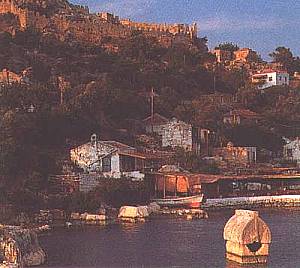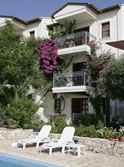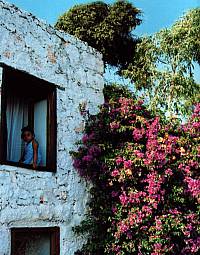
Kas
Of ancient Antiphellus, as Kas was once known, only for the Lycian rock cut tombs and sarcophagi are left. But the charm of the town remains, and it is a pleasure to wander through the streets, stopping to examine souvenir shops that offer Turkish handicrafts, leather goods, copper and silver items, cotton clothing and the inevitable handmade carpet.
The island of Kekova will probably be your next stop either for a day trip or if lucky for overnite. As trade between the Lycians and the other Hellenistic Greeks increased so did piracy and many harbours and ports were fortified in the same way that Kekova is. Again you'll see the remains of buildings and walls beneath your boat, and, depending on the knowledge of your guide, various bits and pieces will be pointed out to you. You'll stop a couple of times for swimming and snorkelling, a couple of caveats for you here. You should watch out for the spiny sea urchins that hang out in the ruins and you should be aware that skin diving near the submerged buidlings is prohibited, as is the removal of any old looking stuff that you might find. You will regret it if you don't tyake a snorkel and mask with you but exercise a little restraint, your captain should know where its OK for you to dive.
Kekova is a name given to the most scenic area in Lycia along the Turquoise Coast. It covers a large area consisting of Kekova Island, Kale (Castle)-ancient name is Simena- village and Ucagiz (the Three Mouths) village. Although there is a winding road that reaches this area, it is easier and more pleasant to go there by boat which takes about two hours either from Kas or Demre. A sunken city was formed by the submergence of ancient cities probably due to earthquakes. The Tersane (shipyard) can still be seen on the shore of Kekova Island. Both the sunken city and the Tersane are thought to be from either the Lycian or Byzantine period, but neither of them has been excavated. On a narrow section of the western side of the island are the ruins of a Byzantine Church with its apse still visible.
The village of Kale has been identified as the Lycian town of Simena where there is still a settlement with stone cottages mixed in with Lycian and Roman remains. A Lycian sarcophagus standing in the shallows of the harbor of Simena is the most notable ruin. Other remains in the village are a 1C AD Roman baths complex, a medieval castle with its walls still standing to their full height, a small theater carved out of rock for approximately 300 people, cisterns and a necropolis with sarcophagi and rock-cut tombs out of the walls of the castle.
As you move on to the mainland village of Kale (ancient Simena) you'll notice the unusual shapes of the islets and outcrops that you pass. These are the result of quarrying to the water line to provide stone for the buildings you've been looking at all day. The approach to Kale is delightful. The medieval castle sitting high on the hill is surrounded by the remains of the ancient city and the climb to the summit, through the little village where you'll probably have lunch, is worth it just to sit in the little theatre and gaze out over the bay to Kekova. The odd Lycian ogival tomb lying around reminds of where you are, you'll see them throughout this part of Turkey, and the village itself is charming in the way that it is built in to the remains of what was here before. Don't forget to check out the other side of the castle with its view to Ucagiz, where you'll probably go next.
The 'three mouths' of Ucagiz are the two openings east and west of Kekova island and the channel to the village itself. Ucagiz is accessible by road from the main Kas - Kalkan highway and is therefore a little more developed although its still fairly sleepy and laid back. There are pansiyons and restaurants here and you could plan to stay a couple of days to take in the delights of the area more fully.
|











